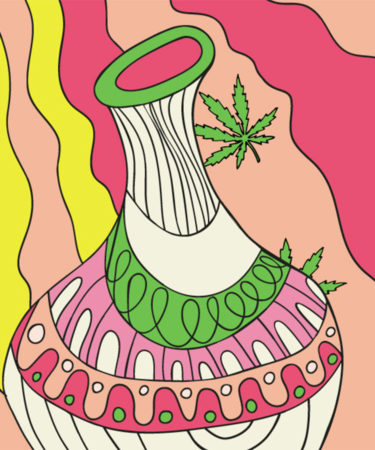The presidential election aside, a resounding “WOOHOO” could be heard coast to coast last week as marijuana became legal for recreational use in four new states. This means that now over half the states in this great nation are green-friendly!
It’s no surprise then that weed and wine can be consumed in the same package, and (being a devoted wine scientist and consumer advocate) I couldn’t resist coordinating a taste test.
For the sake of science, we tried a weed-infused wine made in the traditional, homestyle fashion. Unlike complex, commercially produced cannabis wines like Melissa Ethridge’s “No Label,” which use a marijuana tincture to infuse a wine, the traditional method simply dumps a pile of marijuana into fermenting wine. Over the course of fermentation, alcohol pulls THC into the wine, similar to how THC is extracted into butter or oil.
The “Cannabis Cooler,” as we affectionately came to name it, was tasted by a panel of sommeliers, winemakers, wine buyers and a lone non-industry civilian, in a lineup against traditional wines. Our goal was threefold: (1) to find out if we liked the Cannabis Cooler; (2) to determine how its taste compared to conventional wines; and (3) to decide if we would buy this wine again.
We broke the wine down Court of Master Sommeliers-style. Without knowing what it was, our panel analyzed the appearance, nose and flavors of the wine, and then guessed its origin.
But as soon as the weed wine was poured, these wine-lovers spotted it. Though bright crimson, the wine was cloudy and had some sediment.
Overheard: “Laura, this is pretty obvious.”
Despite being paired alongside distinctive, herbaceous red wines, the nose gave away the additive in the Cannabis Cooler. It was skunky and ashy — reminiscent of a car ashtray. We were not exactly eager to drink it. But over the course of our tasting, the off-aromas of ash and chemicals dissipated, revealing aromas of tropical flowers and ripe, jammy fruit like cherry and raspberry.
Overheard: “This is like freshly cut hay, topped with green mold.”
Quite fortunately, the taste of this wine was completely different from its nose. The Cannabis Cooler was still funky, but with a great, high-acid backbone and mild tannins. In a lot of ways, it was like Beaujolais — funky, earthy and fruity. Herbal notes like thyme stood out, and we all went back for second and third sips. Surprisingly, this wine didn’t taste much like marijuana or the ashtray sensation of the nose, which was surely another cause for celebration.
Overheard: “I thought this would taste like bong water, but it’s so much better!” “I’m really enamored of this — really I am!” “This is like the Starbucks Hibiscus Berry Cooler.”
Thanks to confusing aromas and flavors, we weren’t able to guess this wine, which turned out to be a California Pinot Noir. The bottle would likely have retailed around $30, a price the panel agreed was fair, cannabis-infused or otherwise. Compared to commercial cannabis wines, that’s cheap; Know Label and Green Wine retail for around $20 per ounce. At that rate (roughly $120 per glass) none of us would drop the cash, though we would give our palates over to science if the occasion arose.
Of course, the real question is, did we feel it? A resounding YES. Drinking half a glass of this wine was like pounding three glasses of Champagne on an empty stomach. We certainly wouldn’t recommend driving, but the sensation was pleasant and silly — like bubbles, it went straight to our heads.
Overall, we did like the Cannabis Cooler, and if it were offered to us again, we’d certainly drink it. Compared with traditional wines, this was completely different — more full-bodied than most Pinot Noirs and certainly more potent. Mostly, we were left wondering exactly how THC interacts with alcohol, and guessing the unknowns of this wine — the alcohol percentage, the cannabis strain and potency, oak treatment and other winemaking minutia. Like winemaking, marijuana cultivation and processing dramatically affect the end product, meaning there could be as much variation in Cannabis Coolers as in traditional wines.
Clearly, more experimentation is necessary. Until then, drink with caution!
